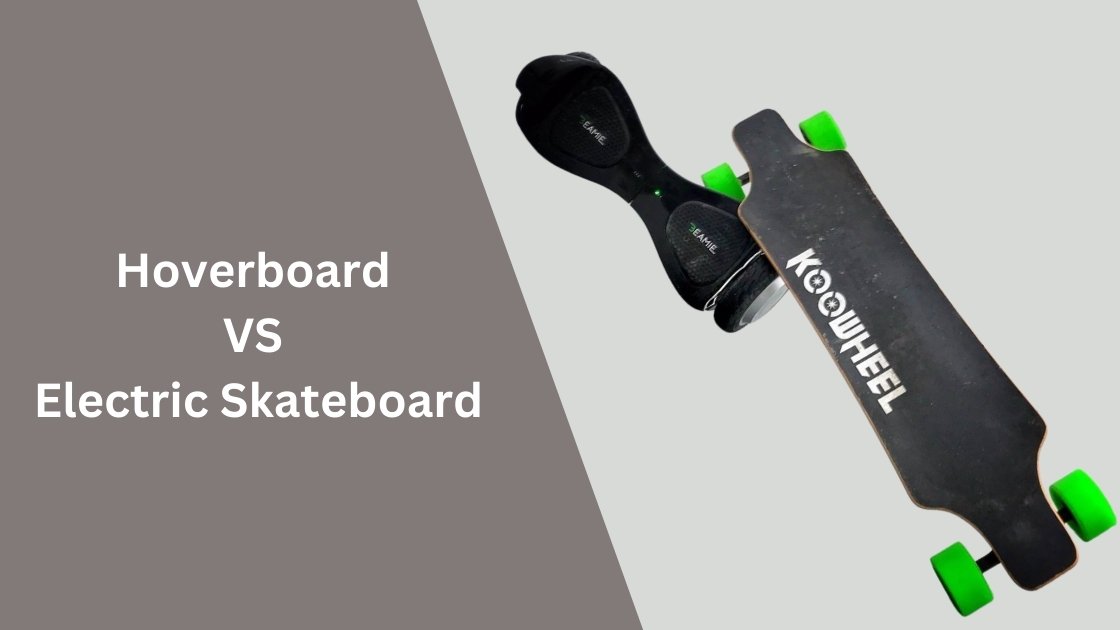As someone who loves to ride and explore the outdoors, I’ve always been interested in both hoverboards and electric skateboards. Both of these devices offer a unique and convenient way to get around, but they also have some differences that make them better suited for certain situations.
In this article, I’ll take a closer look at hoverboards and electric skateboards to help you decide which one is right for you. I’ll cover the pros and cons of each, as well as how they compare in terms of performance, cost, and other factors.
Hoverboard vs Electric Skateboard
Table comparing hoverboards and electric skateboards
| Feature | Hoverboard | Electric Skateboard |
| Price | Typically less expensive | Typically more expensive |
| Ease of use | Easier to learn to ride | More difficult to learn to ride |
| Speed | Typically slower | Typically faster |
| Range | Typically shorter range | Typically longer range |
| Durability | Less durable | More durable |
| Maneuverability | More maneuverable | Less maneuverable |
| Safety | Considered safer | Considered less safe |
| Legality | Some cities have banned hoverboards | Electric skateboards are legal in most places |
| Ideal use | Short trips, commuting, cruising | Long trips, tricks, off-road |
The best choice for you will depend on your individual needs and preferences. If you are looking for a cheap, easy-to-use, and maneuverable vehicle for short trips, then a hoverboard may be a good choice.
If you are looking for a faster, more durable, and safer vehicle for long trips or tricks, then an electric skateboard may be a better choice.
As someone who loves to ride, I’ve always been fascinated by the various options for personal transportation. From bikes to scooters to skateboards, there are so many different ways to get around. But in recent years, two newer options have emerged as popular choices for both commuters and recreational riders: hoverboards and electric skateboards.
Overview of Hoverboard vs Electric Skateboard
Before we dive into the details of hoverboards and electric skateboards, let’s take a quick look at what each of these devices is and how they work.
Hoverboards
Hoverboards, also known as self-balancing scooters, are small, portable devices with two wheels and a platform to stand on. To ride a hoverboard, you stand on the platform and use your body weight to control the direction and speed of the device. Hoverboards are typically used for cruising around town, commuting to work or school, or just having fun.

Electric Skateboards
Electric skateboards are similar to traditional skateboards, but they have a small electric motor that provides additional power to the wheels. To ride an electric skateboard, you stand on the deck and use your weight to control the acceleration and direction of the board. Electric skateboards are typically used for cruising around town, commuting to work or school, or doing tricks.

Pros and Cons of Hoverboards
Now that we have a basic understanding of hoverboards, let’s take a look at some of the pros and cons of these devices.
Pros of Hoverboards
Portability
One of the biggest advantages of hoverboards is their portability. With their small size and lightweight design, hoverboards are easy to carry around and store when you’re not using them. This makes them a convenient and flexible option for people who need to get around.
Maneuverability
Another pro of hoverboards is their maneuverability. With their small size and responsive sensors, hoverboards are easy to turn and weave through tight spaces. This makes them a good choice for people who need to navigate crowded sidewalks or navigate through tight spaces.
Ease of Use
Hoverboards are also relatively easy to use, even for beginners. With their self-balancing design, hoverboards require minimal effort to stay upright and maintain balance. This means that you can learn to ride a hoverboard in just a few minutes, even if you have no prior experience.

Cons of Hoverboard
Limited Range
One of the main drawbacks of hoverboards is their limited range. Most hoverboards have a range of around 10-15 miles per charge, which may not be sufficient for longer commutes or trips. This means that hoverboards may not be the best choice for people who need to travel longer distances or who live in rural areas.
Terrain
Another potential downside of hoverboards is their limited terrain capabilities. While hoverboards can handle smooth, paved surfaces with ease, they may struggle on rough or uneven terrain. This means that hoverboards may not be the best choice for people who need to navigate off-road paths or trails.
Durability
Finally, hoverboards may not be as durable as electric skateboards. Since hoverboards rely on sensitive sensors and electronics to maintain balance, they may be more prone to damage or malfunction if they are dropped or subjected to rough treatment. This means that hoverboards may not be the best choice for people who plan on doing tricks or riding in rough terrain.
Pros and Cons of Electric Skateboards
Now let’s take a look at the pros and cons of electric skateboards.
Pros of Electric Skateboards
Power and Speed
One of the biggest advantages of electric skateboards is their power and speed. With their electric motor you can have more speed while commuting to college or market.
Range
Another pro of electric skateboards is their range. Most electric skateboards have a range of around 10-20 miles per charge, which is significantly longer than the range of most hoverboards. This means that electric skateboards may be a better choice for people who need to travel longer distances or who live in rural areas.
Terrain
Electric skateboards are also more versatile when it comes to terrain. With their larger wheels and more powerful motors, electric skateboards can handle rough or uneven terrain with ease. This makes them a good choice for people who need to navigate off-road paths or trails.
Durability
Finally, the best electric longboards brand tend to be more durable than hoverboards. With their sturdy construction and high-quality components, electric skateboards can withstand the rigors of off-road riding and tricks. This makes them a good choice for people who plan on doing tricks or riding in rough terrain.

Cons of Electric Skateboard
Cost
One potential drawback of electric skateboards is their cost. While you can find some budget-friendly models, most electric skateboards are more expensive than hoverboards, with prices ranging from $300 to over $1,000. This can be a significant financial investment for some people, especially if you’re on a tight budget.
Weight and Size
Another potential downside of electric skateboards is their weight and size. Most electric skateboards are larger and heavier than hoverboards, which can make them less portable and more difficult to carry around. This can be an issue for people who need to travel with their devices or who don’t have a lot of storage space.
Learning Curve
Finally, electric skateboards may have a steeper learning curve than hoverboards. While they’re relatively easy to ride once you get the hang of them, electric skateboards can be intimidating for beginners. It can take some time and practice to get comfortable balancing on the board and controlling the direction and speed of the skateboard.
Comparison of Hoverboards and Electric Skateboards
Now that we’ve looked at the pros and cons of hoverboard vs electric skateboard, let’s compare the two devices to see which one might be the best fit for you.
Cost
One of the main differences between hoverboards and electric skateboards is their cost. In general, hoverboards are more affordable than electric skateboards, with most models costing around $100 or less. Electric skateboards, on the other hand, tend to be more expensive, with prices ranging from $300 to over $1,000.
Range
Another key difference between hoverboards and electric skateboards is their range. Most hoverboards have a range of around 10-15 miles per charge, while electric skateboards have a range of around 10-20 miles per charge. This means that electric skateboards may be a better choice for people who need to travel longer distances or who live in rural areas.
Terrain
When it comes to terrain, electric skateboards are generally more versatile than hoverboards. With their larger wheels and more powerful motors, electric skateboards can handle rough or uneven terrain with ease. The best all-terrain electric skateboard easily rides on the rough road. Hoverboards, on the other hand, are better suited for smooth, paved surfaces.
What are Hoverboards and Electric Skateboards?
Hoverboards are self-balancing scooters that use gyroscopes and sensors to keep the rider upright and moving. They have two wheels and are powered by lithium-ion batteries, which allow them to reach speeds of up to 10 mph. They’re also portable and lightweight, making them a convenient option for getting around town.
Electric skateboards, on the other hand, are essentially traditional skateboards with a motor and battery attached. They can reach speeds of up to 20 mph and are typically longer and wider than traditional skateboards, providing a stable and smooth ride.
Advantages of Hoverboards
One of the main advantages of hoverboards is their ease of use. Because they are self-balancing, they are much easier to ride than traditional skateboards, which require the rider to constantly balance themselves. This makes them a great option for beginners or people who are just getting into riding.
Another advantage of hoverboards is their portability. They are small and lightweight, making them easy to carry around and store. This makes them a great option for commuting or running errands, as you can easily take them with you on the bus or train.
Advantages of Electric Skateboards
While hoverboards are easier to ride, electric skateboards offer a more exhilarating and dynamic experience. Because they have a motor and can reach higher speeds, they offer a more thrilling ride than hoverboards. This makes them a great option for experienced riders who are looking for a bit of a thrill.
Electric skateboards are also more versatile than hoverboards. Because they are essentially traditional skateboards with a motor, they can be used for both commuting and recreational riding. You can use them to get around town or take them to the skate park for some tricks and stunts.
Which is Right for You?
Ultimately, the decision between a hoverboard and an electric skateboard comes down to personal preference. If you’re looking for a convenient and easy-to-ride option for commuting or running errands, a hoverboard might be the better choice for you. However, if you’re an experienced rider looking for a bit of a thrill, an electric skateboard might be more up your alley.
Considerations for Both
Regardless of which option you choose, there are a few things to keep in mind. First and foremost, safety is always a concern when riding any personal transportation device. Be sure to wear a helmet and appropriate safety gear, and always follow local laws and regulations.
Additionally, both hoverboards and electric skateboards have a limited range, typically around 10-15 miles on a single charge. This is something to consider if you plan on using either of these devices for long distance commuting.
Conclusion
Based on the provided search results, here’s a table comparing Hoverboards and Electric Skateboards:
| Aspect | Hoverboard | Electric Skateboard |
| Safety | Electric skateboards are considered safer. | Electric skateboards have four wheels for enhanced stability. |
| Stability | Hoverboards may have a steeper learning curve for beginners. | Hoverboards have two wheels, which may affect stability. |
| Learning Curve | Electric skateboards may be easier for beginners to learn and adopt. | Electric skateboards often have higher top speeds and longer range. |
| Performance | Hoverboards generally have a lower price range compared to electric skateboards. | Hoverboards typically have lower top speeds and shorter range compared to electric skateboards. |
| Cost | Hoverboards generally have a lower price range compared to electric skateboards . | Electric skateboards tend to be more expensive. |
| Pros and Cons | Hoverboards have their pros and cons . | Electric skateboards have their pros and cons . |
| Overall Assessment | Final thoughts on Electric Skateboard vs. Hoverboard. | N/A |
Please note that the provided table is based on the limited information from the search results. For a more comprehensive analysis, I recommend referring to the provided sources:
Hoverboards and electric skateboards are both fun and convenient options for getting around, but they each have their own unique set of advantages and disadvantages. Ultimately, the right choice for you will depend on your personal preferences and needs.
If you’re new to riding or just looking for a convenient and easy-to-use option for commuting or running errands, a hoverboard might be the way to go. They are self-balancing and easy to ride, and their small size and portability make them a great choice for getting around town.
On the other hand, if you’re an experienced rider looking for a bit of a thrill, an electric skateboard might be more up your alley. They offer a more dynamic and exciting ride, and their versatility allows you to use them for both commuting and recreational riding.
No matter which option you choose Hoverboard vs Electric Skateboard, be sure to prioritize safety and always follow local laws and regulations. Happy riding!
More Post




